Heitjans P., Karger J. (Eds.). Diffusion in Condensed Matter: Methods, Materials, Models
Подождите немного. Документ загружается.

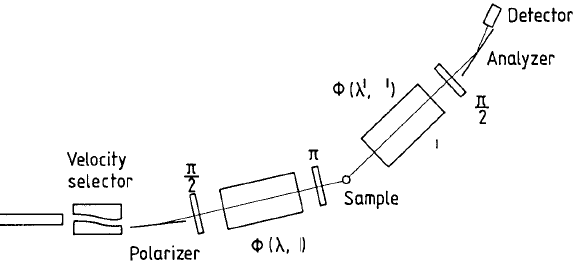
13 Viscoelasticity and Microscopic Motion in Dense Polymer Systems 519
B
B
B
B
Fig. 13.3. Schematic representation of a neutron spin-echo spectrometer.
coil now only projects the x-component of polarization from a general direc-
tion into the z-direction. This part of the polarization is then identified by
the analyser. Apart from resolution corrections, the final polarization P
f
is
obtained from the initial polarization P
i
as
P
f
= P
i
+∞
−∞
dωS(Q, ω)cosωt . (13.4)
The polarization P
f
is proportional to the Fourier transform of the scattering
function S(Q, ω). The transformation from δλ to ω gives the relation between
Fourier time, wavelength and magnetic field as t ∝ λ
3
B.NSEisaFourier
technique, which measures the real part of the intermediate scattering func-
tion S(Q, t). The time variation in a spin-echo experiment is performed by
changing the magnetic field.
Figure 13.4 shows a technical realization of the spin-echo spectrometer
at the J¨ulich FRJ-2 research reactor. Particularly striking are the Larmor
precession coils in front of and behind the specimen. Furthermore, some of
the coils for the spin angular operations can be recognized.
13.3 Local Chain Dynamics and the Glass Transition
The local chain motion under the influence of freezing processes is character-
ized by a very broad range of time scales. Figure 13.5 displays a relaxation
map for (1–4) polybutadiene (PB) sketching the major dynamical features
of a glass-forming polymer. The shown data points are taken from dielec-
tric studies [27], from measurements of the dynamical modulus [28] and from
neutron scattering [4,7,29].
We distinguish three different dynamical regimes:
(i) the freezing process is controlled by the structural α-relaxation exhibit-
ing a pronounced non-Arrhenius temperature dependence. Phenomeno-
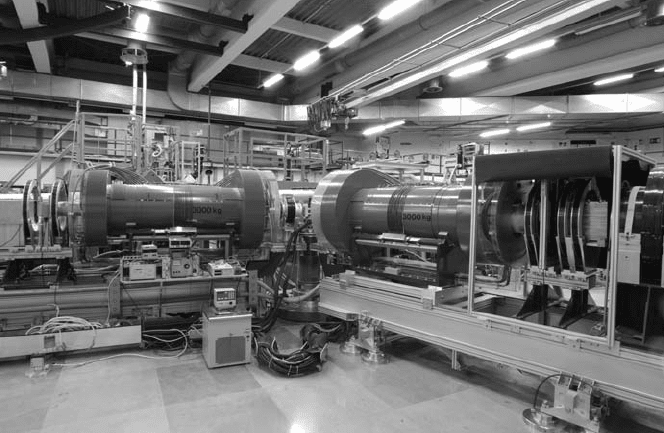
520 Dieter Richter
Fig. 13.4. The neutron spin-echo spectrometer in the ELLA laboratory at the
FRJ-2 of FZ J¨ulich. The two large coils producing the precession fields are clearly
visible. The smaller Helmholtz coils are used for the spin angular operations.
logically it is well described by a Vogel-Fulcher temperature dependence:
τ
−1
∝ exp(−B/(T − T
0
)).
(ii) At a temperature about 20% above T
g
a secondary relaxation process,
the β
slow
relaxation, splits from the α-process. Other than the primary
α-relaxation β
slow
follows an Arrhenius law and is not affected by the
glass transition.
(iii) At high frequencies, in the picosecond range, characteristic low frequency
excitations – the Boson peak and the associated fast relaxation process
called β
fast
are indicated [30]. Following Fig. 13.5 the relevant time scales
for the glass process from the Boson peak and the fast relaxations to the
freezing α-relaxation span 14–15 orders of magnitude.
Though the relaxation dynamics of polymers has been investigated by
relaxational methods at least for five decades, still little is known about the
underlying molecular motions. In principle, varying the momentum transfer
Q, quasielastic and inelastic neutron scattering is capable of providing the
space-time resolution in order to access the relaxations on a molecular level. In
this section we discuss results from coherent quasielastic neutron scattering
on the relaxational dynamics in the α/β
slow
merging region [9, 14, 15] and
relate them to some recent incoherent (QENS) results on the self motion
[18,31].
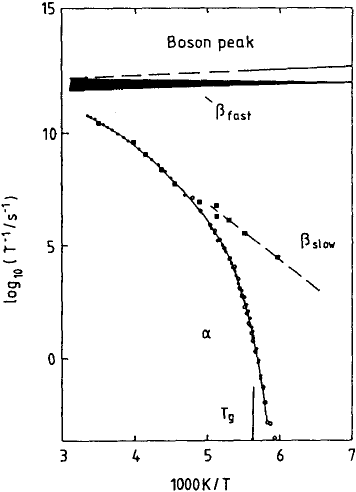
13 Viscoelasticity and Microscopic Motion in Dense Polymer Systems 521
Fig. 13.5. Relaxation map
for (1–4) polybutadiene cover-
ing the prevailing dynamical fea-
tures around the glass transition.
The frequency range for the Bo-
son peak and the associated fast
relaxation-like dynamics (β
fast
)
are indicated schematically. The
full and open circle along the
α-relaxation trace represent di-
electric [27] and mechanical
[28] results, respectively. The
full squares display characteristic
rates obtained from neutron spin
echo spectroscopy [4,9]. The time
scale of the α-process has been
shifted to match that of the mi-
croscopic data. The dashed line
represents the temperature de-
pendence of the β
slow
process ob-
served by dielectric spectroscopy
[15].
13.3.1 Dynamic Structure Factor
We begin by displaying the qualitative behavior of the dynamic structure
factor and then turn to a quantitative evaluation. Figure 13.6 shows the
intermediate dynamic structure factor as measured by NSE (cf. (13.1)) at a
Q-value close to the first minimum of the static structure factor S(Q)[9].Ac-
cording to the time-temperature superposition principle the time dependence
of S(Q, t) was rescaled with the time scale of the α-relaxation as obtained
from dynamic mechanical measurements [32]. Above the merging tempera-
ture of the α and β
slow
relaxation T
m
≈ 220 K (see Fig. 13.5) the different
spectra collapse to a single master curve following a Kohlrausch-William-
Watts (KWW) time dependence: τ
−1
KWW
∝ exp
−(t/τ
0
)
β
with β =0.41.
Below 220 K severe deviations from scaling are observed which are accompa-
nied by an increase of the amplitude of the relaxation function. As we shall
see this deviation from scaling is a signature of the β
slow
process.
We now inspect the Q-dependence of the dynamic structure factor in
more detail. Figure 13.7 displays NSE spectra taken at the position of the
first and second peak of S(Q) – the first peak or amorphous halo thereby
relates mainly to interchain correlations while the second peak stems from
intrachain distances. The data were rescaled with the time scale τ
η
set by
the viscosity relaxation. At the first peak all data collapse on a single master
curve, which can be described by a stretched exponential using the dielectric
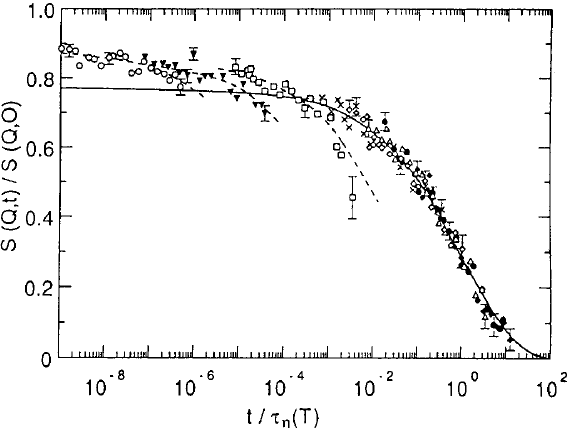
522 Dieter Richter
Fig. 13.6. Selected neutron spin echo spectra obtained at Q =1.88
˚
A
−1
from
polybutadiene [14]. The time was rescaled to the viscosity scale. ( 280 K, • 260 K,
250 K, ♦ 240 K, + 230 K, 205 K, 190 K, ◦ 180 K) The solid line represents the
master curve obtained from the spectra at temperatures higher than 220 K. The
dashed lines represent individual fits to the low temperature data.
stretching exponent β
diel
=0.41. In contrast, at the second peak the spectra
do not follow the time-temperature superposition principle determined by τ
η
and strong deviations from a single master curve are obvious.
Extracting characteristic times from both sets of spectra, those from the
interchain peak follow, as already signified by the master plot, the Vogel-
Fulcher temperature dependence of the α relaxation, while those from the
second peak obey an Arrhenius law with an activation energy identical to
that of the dielectric β relaxation [14]. Thus, at the two first structure factor
peaks qualitatively different aspects of the chain dynamics are observed; at
the interchain peak the diffusive structural relaxation stands out, while at
the intrachain peak the more local β
slow
relaxation dominates the density
fluctuations.
In the range of pure β
slow
relaxation below the merging temperature T
m
the main features of the dynamic structure factor can be understood in terms
of a simple model based on local jump processes with jump rates determined
by a Gaussian distribution of energy barriers as derived from dielectric re-
laxation. The β
slow
relaxation is assumed to be a spatially localized process.
The simplest picture of an elemental motion is a jump of an atom between
two equivalent sites separated by a distance d with a characteristic time
τ = τ
0
exp(E
A
/k
B
T )whereE
A
is the activation energy and k
B
the Boltzmann

13 Viscoelasticity and Microscopic Motion in Dense Polymer Systems 523
Fig. 13.7. Scaling representation of neutron spin echo data from polybutadiene at
Q =1.48
˚
A
−1
(◦ 280 K, • 260 K, 240 K, 230 K, 220 K (upper figure) and at
Q =2.71
˚
A
−1
(◦ 300 K, • 280 K, ♦ 260 K, 240 K, 220 K, 205 K, 190K, |
180 K, 170 K). The solid lines correspond to KWW functions (see text) [15].
constant. For such hopping processes the incoherent intermediate scattering
function is given by
S
hop
inc
(Q, t)=1−
1
2
1 −
sin Qd
Qd
+
1
2
1 −
sin Qd
Qd
e
−2t/τ
=1− A
hop
(Q, d)+f
hop
(Q, d, τ, t) . (13.5)
Coherent and incoherent scattering differ with respect to the presence of in-
terference terms in the coherent scattering. Let us consider the jump motion
of a pair of atoms. If such atomic jumps are uncorrelated, dynamic con-
structive interferences are absent and it follows naturally that the dynamic
quasielastic part assumes the form of the incoherent part. Note, however, that

524 Dieter Richter
interference terms from the average atom distribution remain giving rise to
S(Q). If the motions are correlated it can be shown that interference effects
are small as long as the jump distances are smaller than the distances be-
tween atom pairs. Under this assumption the coherent inelastic part can be
approximated by the incoherent inelastic part, and the normalized coherent
scattering function can be written as
S
β
coh
(Q, t)
S(Q)
=1−
A
hop
(Q, d)
S(Q)
+
f
hop
(Q, d, τ, t)
S(Q)
. (13.6)
Figure 13.8 displays the result of the fit with this model to the Q and T
dependent spectra. Implying for the jump distance the slight barrier energy
dependence of the soft potential model d ∝ E
1/4
A
a most probable jump dis-
tance of d =0.15 nm evolves. Furthermore, the experiment reveals the very
astonishing result that the density fluctuations, which are directly observed
by the neutrons, decay two orders of magnitude faster than the dipole reori-
entations seen by dielectric spectroscopy (see also [33]).
The total scattering function for the β
slow
process then follows from an
averaging over the different relaxation times with the energy barrier distrib-
ution from dielectric spectroscopy.
Figure 13.9 shows the relative quasielastic contribution of the β
slow
process
to the structure factor as calculated on the basis of the parameters obtained
by the fitting procedure. The result explains immediately the qualitatively
different behavior of S(Q, t)atthefirsttwomaximaofS(Q). Due to the
renormalization of the quasielastic part in (13.6) with S(Q) the contribution
of the β
slow
process at the first maximum of S(Q) is minute, while it becomes
very strong close to the second maximum explaining the Arrhenius behavior
of the characteristic times at high Q. Further evaluation considering explicitly
the coherent form factor of the moving rigid building blocks of the chain (cis
and trans units involving the double bond) essentially confirms the outcome
of the analysis within the simple hopping model [15].
At temperatures around the merging temperature T
m
and above, the time
scales of α-andβ-relaxations become similar and consequently the dynamic
structure factor has to be generalized in order to include the structural α-
relaxation or so-called segmental diffusion. When this segmental diffusion
reaches the timescale of the local relaxation, the atoms and molecular groups
will noticeably participate simultaneously in both motional mechanisms: the
intrachain β-relaxation and the interchain α-relaxation. We assume that to
first order both mechanisms are statistically independent from each other.
We shall see that on the basis of this hypothesis the Q- and temperature-
dependent dynamic structure factors in the merging regime and above can
be consistently accounted for.
Being a conditional probability, the self-correlation function correspond-
ing to an atom undergoing two different statistically independent motions,
α and β, can be written as a convolution product of the corresponding self-
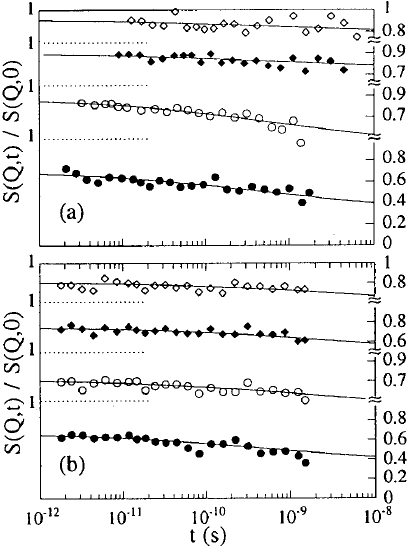
13 Viscoelasticity and Microscopic Motion in Dense Polymer Systems 525
Fig. 13.8. Neutron spin echo spectra from polybutadiene a) at T = 205 K and
for different Q-values ♦ 1.4
˚
A
−1
, 1.56
˚
A
−1
, ◦ 1.88
˚
A
−1
, • 2.55
˚
A
−1
; and b) at
Q =2.71
˚
A
−1
for various temperatures ♦ 170 K, 180 K, ◦ 190 K, • 205 K. The
ordinates corresponding to each spectrum are given on the left and right side,
respectively. Solid lines correspond to the fit with the hopping model for the β-
relaxation [14].
correlation functions:
G
αβ
S
(r,t)=
G
β
S
(r,t)G
α
S
(r − r
,t)dr . (13.7)
This implies that the incoherent structure factor obtained by Fourier transfor-
mation of G
αβ
S
(r,t) becomes a product of the structure factors corresponding
to the two processes:
S
αβ
S
(Q,t)=S
α
S
(Q,t)S
β
S
(Q,t) . (13.8)
In the coherent case the derivation of a similar expression is not straightfor-
ward because the correlations between all the pairs of scatterers (j, i)have
to be taken into account. It can be shown that a relation similar to (13.8)
holds if for the segmental diffusion the incoherent approximation is made.

526 Dieter Richter
Fig. 13.9. Amplitude of the relative quasielastic contribution of the β
slow
process
to the coherent scattering function obtained from the hopping model as a function
of Q. The static structure factor S(Q) at 160 K is shown for comparison (solid
line) [14].
This assumption corresponds to the so-called Vineyard approximation [34],
in which S
β
coh
(Q, t) takes the role of S(Q).
In incoherent approximation the relaxation function for the α-process ϕ
α
can be described by a KWW function
ϕ
α
(Q, t)=exp
−
t
τ
KWW
(Q, t)
β
(13.9)
with β =0.41 from the shape of the dielectric spectra. τ
KWW
(Q, t)isthechar-
acteristic Q- and temperature-dependent relaxation time. With the structure
factor for the β-process evaluated at low temperature (see above) we obtain
similar to (13.8)
S
αβ
(Q, t)
S(Q)
= ϕ
α
(Q, t)S
β
coh
(Q, t)/S(Q) . (13.10)
All parameters involved in the coherent structure factor of the β-relaxation
are known from the evaluation at low T and are extrapolated to the higher
temperatures. Figure 13.10 shows the comparison between theory and exper-
iment for several temperatures at the first maximum, minimum and sec-
ond maximum of S(Q) (Fig. 13.10a) and for 260 K at different Q-values
(Fig. 13.10b). The excellent agreement between the scattering function
(cf. (13.10)) and the experiment strongly supports the hypothesis that the
α-andβ-relaxation occur independently of each other.

13 Viscoelasticity and Microscopic Motion in Dense Polymer Systems 527
Fig. 13.10. Data from polybutadiene: (a) NSE-spectra for the Q-values indicated
at 220 K (); 240 K (); 260 K () and 280 K (♦). (b) at 260 K for the Q-values
indicated. The solid lines display the model predictions.
13.3.2 Self-Correlation Function
In Gaussian approximation [20] the self-correlation function for a diffusive
process is directly related to the mean square displacement r
2
(t) by
S
self
α
(Q, t)=exp
−
Q
2
6
r
2
(t)
. (13.11)
It is measured by analyzing the incoherent scattering from protonated sam-
ples. For the α-process the scattering functions are well described by stretched
exponentials (see (13.9)). It is worthwhile to note that (13.11) is completely
equivalent to the expression for spin-echo attenuation ((10.18) of Chap. 10
with the product D∆ expressed by the mean square displacement) of pulsed
field gradient NMR, whence in the latter technique the quantity γδg assum-
ing the position of Q is sometimes referred to as a generalized scattering
vector.
528 Dieter Richter
If the system is homogenous, i.e. all particles undergo the same fate on the
time scale of observation, then a combination of (13.11) and (13.9) implies
r
2
(t) =
˜
Dt
β
and τ
KWW
(Q) ∼ Q
−2/β
(13.12)
invoking sublinear diffusion of the polymer segments as the underlying rea-
son for the stretched exponential dependence. Its signature is a power-law
dependence of the Kohlrausch-Williams-Watts relaxation times τ
KWW
with
an exponent 2/β.
Figure 13.11 displays the τ
KWW
values obtained by backscattering spec-
troscopy (see Chap. 3) for four different polymers, polyvinylether (PVE) at
340 K, polyisobutylene (PIB) at 365 K, polybutadiene (PB) at 280 K and
polyisoprene (PI) at 340 K for different momentum transfers [20]. To test
(13.12), the relaxation times have been exponentiated with the exponent β
obtained from the stretching of the relaxation functions in these polymers by
dielectric spectroscopy. According to (13.12) τ
β
KWW
should be proportional
to Q
−2
. The solid lines in Fig. 13.11 display this power law relation. As may
be seen, in all cases the predicted power law within experimental error is
followed by the experimental relaxation times. Recent data on PIB and PI
confirm these results with high accuracy [35,36]. Thus, the experimental ev-
idence supports a sublinear diffusion process as underlying the α-relaxation.
We remark that this result is in disagreement with assertions [19, 37], that
the stretched exponential relaxation function of the α-process originates from
heterogeneous motional processes, where polymer segments in different parts
of the sample would relax at different relaxation rates.
In the temperature range, where the α-relaxation is too slow to be ob-
served by neutron scattering, the β-process can be measured. The correspond-
ing spectra are a superposition of elastic and inelastic components indicative
of a localized motion.
Figure 13.12 displays this elastic part of the intensity, observed for PIB as
a function of Q [31]. The data were corrected for multiple scattering and fitted
with the elastic incoherent structure factor (EISF) for a jump process between
two sites. The EISF is the Fourier transform of the self-correlation function
in the limit of infinite times and reveals the asymptotic proton distribution
(see also (3.18), Chap. 3). The fit reveals the jump distance d =0.27 nm. For
comparison the solid line displays the prediction for methyl group rotation,
which was invoked earlier on the basis of NMR experiments [38]. Within a
factor of two the time scale obtained from the neutron results agrees with that
from dielectric spectroscopy. Since the underlying process has an amplitude
of 0.27 nm and is also dielectrically active, it cannot be understood as due to a
methylgroup rotation alone. A possible interpretation is a combined backbone
and methyl motion, which is also supported by simulation results [39].
Let us draw a first conclusion: Exploiting the Q-dependence of the co-
herent dynamic structure factor, which is accessed by NSE, at temperatures
below the merging temperature T
m
spatial information on the chain motions
